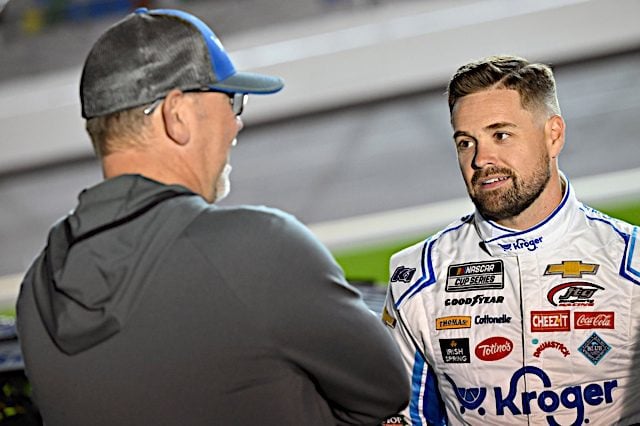Who … should you be talking about after the race?
His team left him a note in his racecar that read, “We Believe. TODAY.” Ricky Stenhouse Jr. didn’t see it until after the race was over — and he’d won the 2023 Daytona 500. Stenhouse worked his way through a pair of overtime restarts (and subsequent multi-car crashes) to take his third career NASCAR Cup Series victory and his second overall at Daytona International Speedway.
Stenhouse lacked one thing most superspeedway drivers can’t do without: a teammate. Stenhouse races for single-car JTG Daugherty Racing, leaving him without a natural partner on track. So, he worked with anyone he could and put himself in position to capitalize on any opportunity.
Had the final caution flown before the white flag, Stenhouse would have been in trouble. He ran out of fuel at the finish, not even having enough in the tank to drive to victory lane. He got there, though, and celebrated an underdog win, the second time in the last three years that a smaller team without the funding of the favorites claimed the win in the Great American Race.
And don’t forget Travis Pastrana. The 39-year-old Pastrana has driven just about anything with wheels over the course of his career — except for a Cup Series car. The X-Games gold medalist had one season driving for Roush Fenway Racing in the Xfinity Series … 10 years ago.
Climbing behind the wheel of the No. 67 for 23XI Racing, Pastrana had to qualify for the race on speed and he did it, locking himself in on his qualifying lap. He started 40th on Sunday (Feb. 19) and did what some of the most experienced drivers in the field couldn’t: avoid trouble. Pastrana finished an impressive 11th in his Cup debut.
What … is the big question leaving this race in the rearview?
After another weekend that saw upwards of half the field involved in at least one incident and 16 cars in the garage before the checkers due to crashes, could it be time for NASCAR to do something to break up the giant packs of cars that has become synonymous with Daytona and Talladega (and now Atlanta as well)?
Smaller packs of cars, think 5-6 in a group, used to be the norm, with one group able to run down another and make moves before splitting into smaller groups again throughout a race.
Sure, high-speed, close-quarters racing has always caused crashes that can get pretty intense. But a dozen or more cars in one wasn’t just another day at a…
Click Here to Read the Full Original Article at …

